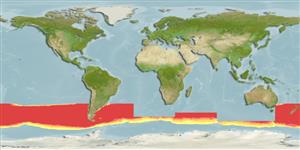>
Lampriformes (Velifers, tube-eyes and ribbonfishes) >
Lampridae (Opahs)
Etymology: Lampris: Greek, lampros = light (Ref. 45335).
Environment: milieu / climate zone / depth range / distribution range
Ecologia
marino; distribuzione batimetrica 50 - 485 m. Temperate; 34°S - 69°S
Circumglobal in the southern hemisphere between 34°S and the Antarctic Polar Front.
Size / Peso / Age
Maturity: Lm ? range ? - ? cm
Max length : 110 cm TL maschio/sesso non determinato; (Ref. 6475); peso massimo pubblicato: 30.0 kg (Ref. )
Short description
Chiavi di identificazione | Morfologia | Morfometria
Spine dorsali (totale) : 0; Raggi dorsali molli (totale) : 55 - 56; Spine anali: 0; Raggi anali molli: 36 - 40.
Feeds on krill, squid and fishes.
Life cycle and mating behavior
Maturità | Riproduzione | Deposizione | Uova | Fecundity | Larve
Gon, O., 1990. Lampridae. p. 215-217. In O. Gon and P.C. Heemstra (eds.) Fishes of the Southern Ocean. J.L.B. Smith Institute of Ichthyology, Grahamstown, South Africa. (Ref. 5188)
IUCN Red List Status (Ref. 130435: Version 2024-1)
Threat to humans
Harmless
Human uses
Strumenti
Special reports
Download XML
Fonti Internet
Estimates based on models
Preferred temperature (Ref.
123201): 1.8 - 11.9, mean 6.1 °C (based on 287 cells).
Phylogenetic diversity index (Ref.
82804): PD
50 = 1.0000 [Uniqueness, from 0.5 = low to 2.0 = high].
Bayesian length-weight: a=0.01995 (0.00906 - 0.04395), b=3.01 (2.83 - 3.19), in cm total length, based on all LWR estimates for this body shape (Ref.
93245).
Trophic level (Ref.
69278): 4.4 ±0.70 se; based on food items.
Resilienza (Ref.
120179): Medio, tempo minimo di raddoppiamento della popolazione 1.4 - 4.4 anni (Preliminary K or Fecundity.).
Fishing Vulnerability (Ref.
59153): High to very high vulnerability (66 of 100).
Climate Vulnerability (Ref.
125649): Moderate to high vulnerability (45 of 100).
Nutrients (Ref.
124155): Calcium = 17 [8, 32] mg/100g; Iron = 0.355 [0.199, 0.637] mg/100g; Protein = 21 [17, 24] %; Omega3 = 0.636 [0.334, 1.270] g/100g; Selenium = 17.9 [8.9, 35.6] μg/100g; VitaminA = 12 [3, 54] μg/100g; Zinc = 0.322 [0.219, 0.489] mg/100g (wet weight);
